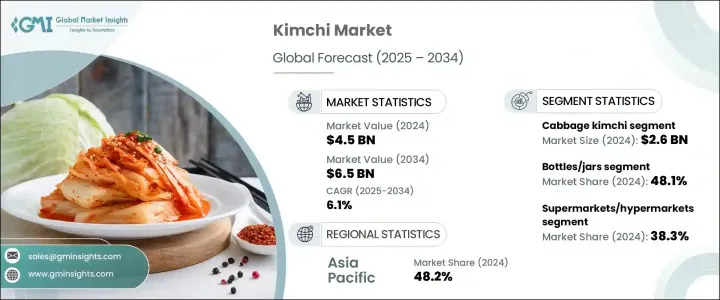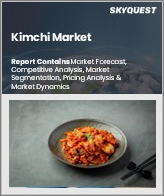
|
시장보고서
상품코드
1755275
세계의 김치 시장 : 기회, 성장 촉진요인, 산업 동향 분석 및 예측(2025-2034년)Kimchi Market Opportunity, Growth Drivers, Industry Trend Analysis, and Forecast 2025 - 2034 |
||||||
세계의 김치 시장은 2024년에는 45억 달러로 평가되었으며 2034년에는 65억 달러에 이를 것으로 추정되며, CAGR 6.1%로 성장할 전망입니다.
이러한 성장은 주로 장 건강과 전반적인 웰빙에 대한 소비자의 인식이 높아진 데 따른 것으로, 한국 발효 식품인 김치는 소화를 돕는 프로바이오틱스가 풍부하게 함유되어 있습니다. 김치의 세계적인 인기는 K-팝과 K-드라마의 세계적인 성공에 힘입어 한국 문화의 부상과 함께 급속히 확산되었습니다. 또한, 김치는 다양한 요리에 쉽게 적용될 수 있는 적응성으로 국제적으로 다양한 요리에 통합되어 그 매력을 확대하고 있습니다. 소비자의 선호도가 유기농, 지속 가능한 원료, 클린 라벨 제품으로 이동하면서 김치, 특히 해산물 성분이 들어가지 않은 식물성 김치의 수요도 증가하고 있습니다.

이 변화는 건강과 환경을 중시하는 소비 트렌드의 일환으로, 특히 비건, 유기농, 클린 라벨 제품을 선호하는 소비자층에서 두드러집니다. 사람들이 식습관의 환경적 영향에 대한 인식이 높아지면서, 건강에 좋고 윤리적으로 생산된 제품에 대한 수요가 눈에 띄게 증가하고 있습니다. 이러한 동향은 동물 복지, 환경의 지속 가능성, 개인 건강에 대한 우려로 촉진된 식물성 식단으로의 광범위한 문화적 변화에 의해 더욱 확대되고 있습니다.
| 시장 범위 | |
|---|---|
| 시작 연도 | 2024년 |
| 예측 연도 | 2025-2034년 |
| 시작 금액 | 45억 달러 |
| 예측 금액 | 65억 달러 |
| CAGR | 6.1% |
2024년에는 배추 김치 부문이 57.5%의 점유율을 차지하여 26억 달러에 달했습니다. 이 품종은 계속해서 시장을 지배할 것이며, 그 다음으로 무로 만든 깍두기 김치와 같은 다른 유형이 그 뒤를 이을 것입니다. 김치의 프로바이오틱 특성은 장내 세균의 균형을 유지하고 소화를 돕고 면역 체계까지 강화합니다. 또한 김치는 칼슘, 철분, 비타민 A, B, C 등 필수 비타민과 미네랄이 풍부하여 건강에 민감한 소비자들이 선택하는 영양가 높은 식품입니다.
병/용기 부문은 2024년에 48.1%의 점유율을 차지했습니다. 병은 주로 경량 플라스틱으로 만들어지며, 특히 바쁜 소비자들이 편리함, 내구성, 가격 대비 효율성을 이유로 선호합니다. 재활용 플라스틱 병을 사용하는 등 친환경 포장의 동향이 증가하면서 환경에 대한 의식이 높은 고객층을 공략하는 데도 도움이 되고 있습니다. 또한, 첨단 병입 기술의 적용으로 유통 기한이 연장되고 신선도가 유지되어 포장 김치의 수요가 더욱 증가하고 있습니다.
아시아태평양 김치 시장은 2024년에 48.2%의 점유율을 차지했습니다. 김치의 발상지인 한국은 여전히 시장에서 지배적인 위치를 차지하고 있습니다. 풍부한 문화 유산과 수백 년에 걸친 김치 제조의 전통은 지속적인 혁신과 성장의 토대를 마련했습니다. 한국에는 국내 수요를 충족할 뿐만 아니라 전 세계적으로 증가하는 발효 식품에 대한 수요를 충족하는 몇몇 대형 김치 제조업체가 있습니다.
세계의 김치 시장의 주요기업으로는 대성코퍼레이션, 풀무원, CJ제일제당, 청가식품, 유진식품 등이 있으며, 이들은 혁신과 유통 능력을 바탕으로 시장을 선도하고 있습니다. 김치 시장의 주요 업체들은 입지를 강화하기 위해 제품 개발과 포장 모두에서 혁신에 주력하고 있습니다. 많은 업체들이 건강에 민감한 소비자의 요구를 충족하기 위해 식물성 및 유기농 제품으로 제품 포트폴리오를 확장하고 있습니다. 또한, 기업들은 친환경적인 구매자를 유치하기 위해 재활용 가능한 플라스틱 병과 같은 지속 가능한 포장 솔루션에 투자하고 있습니다. 일부 업체들은 시장 성장을 촉진하는 핵심 요소인 제품의 유통 기한과 신선도를 개선하기 위해 기술을 활용하고 있습니다. 또한, 국제 유통업체들과의 전략적 파트너십 및 협력을 통해 전 세계 시장에서의 도달 범위와 인지도를 확대하고 있습니다.
목차
제1장 조사 방법과 범위
제2장 주요 요약
제3장 업계 인사이트
- 생태계 분석
- 공급자의 상황
- 이익률
- 각 단계에서의 부가가치
- 밸류체인에 영향을 주는 요인
- 혁신
- 업계에 미치는 영향요인
- 성장 촉진요인
- 업계의 잠재적 위험 및 과제
- 시장 기회
- 성장 가능성 분석
- 규제 상황
- 북미
- 유럽
- 아시아태평양
- 라틴아메리카
- 중동 및 아프리카
- Porter's Five Forces 분석
- PESTEL 분석
- 가격 동향
- 지역별
- 제품별
- 한류가 세계에 미치는 영향 김치시장
- 김치 무역 분석
- 수입 및 수출 시나리오
- 무역장벽과 협정
- 가격 동향 분석
- 김치의 건강과 영양분석
- 프로바이오틱스의 특성
- 영양 성분
- 건강상의 이점
- 과학조사와 임상연구
- 소비자 행동 분석
- 업계 밸류체인 분석
- 장래 시장 동향
- 기술과 혁신의 상황
- 현재의 기술 동향
- 신흥기술
- 특허 상황
- 무역 통계(HS코드)(참고 : 무역 통계는 주요 국가에서만 제공됨)
- 주요 수입국
- 주요 수출국
- 지속가능성과 환경 측면
- 지속가능한 관행
- 폐기물 삭감 전략
- 생산에 있어서의 에너지 효율
- 환경 친화적 인 노력
제4장 경쟁 구도
- 소개
- 기업의 시장 점유율 분석
- 지역별
- 북미
- 유럽
- 아시아태평양
- 라틴아메리카 항공
- 중동 및 아프리카
- 지역별
- 기업 매트릭스 분석
- 주요 시장 기업의 경쟁 분석
- 경쟁 포지셔닝 매트릭스
- 주요 발전
- 합병과 인수
- 파트너십 및 협업
- 신제품 발매
- 확장 계획
제5장 시장 추계 및 예측 : 제품 유형별(2021-2034년)
- 주요 동향
- 배추 김치
- 깍두기 김치
- 통치미 김치
- 나박 김치
- 백김치
- 기타
제6장 시장 추계 및 예측 : 포장 형태별(2021-2034년)
- 주요 동향
- 병/용기 김치
- 진공팩 김치
- 통조림 김치
- 파우치 포장
- 기타
제7장 시장 추계 및 예측 : 유통 채널별(2021-2034년)
- 주요 동향
- 슈퍼마켓 및 대형 슈퍼마켓
- 전문점
- 편의점
- 온라인 소매
- 푸드서비스
- 기타
제8장 시장 추계 및 예측 : 지역별(2021-2034년)
- 주요 동향
- 북미
- 미국
- 캐나다
- 유럽
- 독일
- 영국
- 프랑스
- 스페인
- 이탈리아
- 네덜란드
- 기타 유럽
- 아시아태평양
- 중국
- 인도
- 일본
- 호주
- 한국
- 기타 아시아태평양
- 라틴아메리카
- 브라질
- 멕시코
- 아르헨티나
- 기타 라틴아메리카
- 중동 및 아프리카
- 사우디아라비아
- 남아프리카
- 아랍에미리트(UAE)
- 기타 중동 및 아프리카
제9장 기업 프로파일
- CJ CheilJedang Corp.
- Daesang Corporation(Jongga)
- Pulmuone Co., Ltd.
- Chongga Food Co.
- YOUJIN FOODS CO., LTD.
- Hansung Food Co., Ltd.
- Hae Dam Chon Co., Ltd.
- DAEKWANG F&G CO., LTD.
- Wildbrine
- Mother-in-Law's Kimchi
- Sunja's Kimchi
- King's Asian Gourmet
- Cosmos Food Company Inc.
- Lucky Foods
- Sinto Gourmet
The Global Kimchi Market was valued at USD 4.5 billion in 2024 and is estimated to grow at a CAGR of 6.1% to reach USD 6.5 billion by 2034. This growth is largely driven by increased consumer awareness of gut health and its impact on overall well-being, with kimchi, a fermented vegetable dish from Korea, being rich in probiotics known to support digestion. Kimchi's global popularity has surged with the rise of Korean culture, spurred by the worldwide success of K-pop and K-dramas. Furthermore, its adaptability has allowed it to be integrated into a wide variety of dishes internationally, expanding its appeal. Consumer preferences are shifting toward more organic, sustainably sourced, and clean-label products, which has also contributed to the demand for kimchi, especially plant-based variants made without seafood ingredients.

This shift is part of a larger, growing movement towards health-conscious and environmentally aware consumption, especially among consumers who prioritize vegan, organic, and clean-label products. As people become increasingly mindful of the environmental impact of their food choices, there is a noticeable rise in demand for products that are not only good for their health but also ethically sourced and sustainably produced. This trend is further amplified by a broader cultural shift toward plant-based diets, driven by concerns over animal welfare, environmental sustainability, and personal health.
| Market Scope | |
|---|---|
| Start Year | 2024 |
| Forecast Year | 2025-2034 |
| Start Value | $4.5 Billion |
| Forecast Value | $6.5 Billion |
| CAGR | 6.1% |
In 2024, the Baechu kimchi segment held a 57.5% share, amounting to USD 2.6 billion. This variety continues to dominate the market, followed by other types like kkakdungi kimchi, which is made with radishes. Kimchi's probiotic properties help balance gut bacteria, support digestion, and even enhance the immune system. Additionally, kimchi is a rich source of essential vitamins and minerals like calcium, iron, and vitamins A, B, and C, making it a nutritious choice for consumers seeking health-conscious food options.
The bottles/ jars segment held a 48.1% share in 2024. Bottles, often made of lightweight plastic, are preferred for their convenience, durability, and cost-effectiveness, especially among busy consumers. The rising trend of eco-conscious packaging, including the use of recycled plastic bottles, is also helping to cater to a more environmentally aware customer base. The application of advanced bottling technologies has also improved shelf life and maintained freshness, further boosting the demand for packaged kimchi.
Asia-Pacific Kimchi Market held a 48.2% share in 2024. South Korea, as the birthplace of kimchi, remains the dominant force in the market. Its rich cultural heritage and centuries-old tradition of making kimchi have laid the foundation for continued innovation and growth. The country is home to some of the largest kimchi producers, who not only serve local demand but also cater to the growing global appetite for this fermented dish.
Key players in the Global Kimchi Market include Daesung Corporation, Pulmuone Co. Ltd, CJ CheilJedang Corp., Chongga Food Co., and Youjin Foods Co. Ltd, who are leading the market with their innovations and distribution capabilities. To enhance their presence, major players in the kimchi market are focusing on innovation in both product development and packaging. Many are expanding their product portfolios to include plant-based and organic variants to meet the demands of health-conscious consumers. Additionally, companies are investing in sustainable packaging solutions, such as recyclable plastic bottles, to appeal to eco-conscious buyers. Some players are also leveraging technology to improve product shelf life and freshness, which has been key in driving market growth. Furthermore, strategic partnerships and collaborations with international distributors help expand their reach and visibility in global markets.
Table of Contents
Chapter 1 Methodology & Scope
- 1.1 Market scope and definition
- 1.2 Research design
- 1.2.1 Research approach
- 1.2.2 Data collection methods
- 1.3 Data mining sources
- 1.3.1 Global
- 1.3.2 Regional/Country
- 1.4 Base estimates and calculations
- 1.4.1 Base year calculation
- 1.4.2 Key trends for market estimation
- 1.5 Primary research and validation
- 1.5.1 Primary sources
- 1.6 Forecast model
- 1.7 Research assumptions and limitations
Chapter 2 Executive Summary
- 2.1 Industry 3600 synopsis
- 2.2 Key market trends
- 2.2.1 Regional
- 2.2.2 Product
- 2.2.3 End use
- 2.3 TAM Analysis, 2025-2034
- 2.4 CXO perspectives: strategic imperatives
- 2.4.1 Executive decision points
- 2.4.2 Critical success factors
- 2.5 Future outlook and strategic recommendations
Chapter 3 Industry Insights
- 3.1 Industry ecosystem analysis
- 3.1.1 Supplier landscape
- 3.1.2 Profit margin
- 3.1.3 Value addition at each stage
- 3.1.4 Factor affecting the value chain
- 3.1.5 Disruptions
- 3.2 Industry impact forces
- 3.2.1 Growth drivers
- 3.2.2 Industry pitfalls and challenges
- 3.2.3 Market opportunities
- 3.3 Growth potential analysis
- 3.4 Regulatory landscape
- 3.4.1 North America
- 3.4.2 Europe
- 3.4.3 Asia Pacific
- 3.4.4 Latin America
- 3.4.5 Middle East & Africa
- 3.5 Porter's analysis
- 3.6 PESTEL analysis
- 3.6.1 Technology and innovation landscape
- 3.6.2 Current technological trends
- 3.6.3 Emerging technologies
- 3.7 Price trends
- 3.7.1 By region
- 3.7.2 By product
- 3.8 Impact of Korean wave (Hallyu) on global kimchi market
- 3.9 Kimchi trade analysis
- 3.9.1 Import-export scenario
- 3.9.2 Trade barriers and agreements
- 3.9.3 Price trend analysis
- 3.10 Health and nutritional analysis of kimchi
- 3.10.1 Probiotic properties
- 3.10.2 Nutritional composition
- 3.10.3 Health benefits
- 3.10.4 Scientific research and clinical studies
- 3.11 Consumer behaviour analysis
- 3.12 Industry value chain analysis
- 3.13 Future market trends
- 3.14 Technology and innovation landscape
- 3.14.1 Current technological trends
- 3.14.2 Emerging technologies
- 3.15 Patent landscape
- 3.16 Trade statistics (HS code) ( Note: the trade statistics will be provided for key countries only)
- 3.16.1 Major importing countries
- 3.16.2 Major exporting countries
- 3.17 Sustainability and Environmental Aspects
- 3.17.1 Sustainable practices
- 3.17.2 Waste reduction strategies
- 3.17.3 Energy efficiency in production
- 3.17.4 Eco-friendly initiatives
Chapter 4 Competitive Landscape, 2024
- 4.1 Introduction
- 4.2 Company market share analysis
- 4.2.1 By region
- 4.2.1.1 North America
- 4.2.1.2 Europe
- 4.2.1.3 Asia Pacific
- 4.2.1.4 LATAM
- 4.2.1.5 MEA
- 4.2.1 By region
- 4.3 Company matrix analysis
- 4.4 Competitive analysis of major market players
- 4.5 Competitive positioning matrix
- 4.6 Key developments
- 4.6.1 Mergers & acquisitions
- 4.6.2 Partnerships & collaborations
- 4.6.3 New Product launches
- 4.6.4 Expansion plans
Chapter 5 Market Estimates and Forecast, By Product Type, 2021 - 2034 (USD Million & Units)
- 5.1 Key trends
- 5.2 Baechu (cabbage) kimchi
- 5.3 Kkakdugi (radish) kimchi
- 5.4 Dongchimi (watery radish) kimchi
- 5.5 Nabak kimchi (sliced radish and vegetables)
- 5.6 White kimchi (non-spicy)
- 5.7 Others
Chapter 6 Market Estimates & Forecast, By Packaging Type, 2021 - 2034 (USD Million & Units)
- 6.1 Key trends
- 6.2 Bottled/jarred kimchi
- 6.3 Vacuum packed kimchi
- 6.4 Canned kimchi
- 6.5 Pouch packaging
- 6.6 Other
Chapter 7 Market Estimates & Forecast, By Distribution Channel, 2021 - 2034 (USD Million & Units)
- 7.1 Key trends
- 7.2 Supermarkets/hypermarkets
- 7.3 Specialty stores
- 7.4 Convenience stores
- 7.5 Online retail
- 7.6 Food service
- 7.7 Other
Chapter 8 Market Estimates and Forecast, By Region, 2021 - 2034 (USD Billion) (Kilo Tons)
- 8.1 Key trends
- 8.2 North America
- 8.2.1 U.S.
- 8.2.2 Canada
- 8.3 Europe
- 8.3.1 Germany
- 8.3.2 UK
- 8.3.3 France
- 8.3.4 Spain
- 8.3.5 Italy
- 8.3.6 Netherlands
- 8.3.7 Rest of Europe
- 8.4 Asia Pacific
- 8.4.1 China
- 8.4.2 India
- 8.4.3 Japan
- 8.4.4 Australia
- 8.4.5 South Korea
- 8.4.6 Rest of Asia Pacific
- 8.5 Latin America
- 8.5.1 Brazil
- 8.5.2 Mexico
- 8.5.3 Argentina
- 8.5.4 Rest of Latin America
- 8.6 Middle East and Africa
- 8.6.1 Saudi Arabia
- 8.6.2 South Africa
- 8.6.3 UAE
- 8.6.4 Rest of Middle East and Africa
Chapter 9 Company Profiles
- 9.1 CJ CheilJedang Corp.
- 9.2 Daesang Corporation (Jongga)
- 9.3 Pulmuone Co., Ltd.
- 9.4 Chongga Food Co.
- 9.5 YOUJIN FOODS CO., LTD.
- 9.6 Hansung Food Co., Ltd.
- 9.7 Hae Dam Chon Co., Ltd.
- 9.8 DAEKWANG F&G CO., LTD.
- 9.9 Wildbrine
- 9.10 Mother-in-Law's Kimchi
- 9.11 Sunja's Kimchi
- 9.12 King's Asian Gourmet
- 9.13 Cosmos Food Company Inc.
- 9.14 Lucky Foods
- 9.15 Sinto Gourmet













